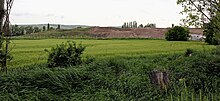Eskiyapar Höyük
Coordinates: 40 ° 9 ′ 29 ″ N , 34 ° 46 ′ 23 ″ E
Eskiyapar Höyük is a fortified settlement mound in northern Turkey that was inhabited from the Early Bronze Age to Roman times . It harbors an important city in the heart of the Hittite Empire.
Research history
The Höyük, which has been known since the 19th century, was first examined in 1945 by Ekrem Akurgal from the excavation team of Alaca Höyük, followed in the same year by Raci Temizer, the director of the Museum of Anatolian Civilizations in Ankara, for a surface investigation . This began the first systematic excavations in Eskiyapar in 1968, which lasted until 1982. This was followed by excavations for the Çorum Museum from 1991 to 1992 . Since 2010 a team from Ankara University under the direction of Tunç Sipahi has been working on excavations again.
hill
The hill is located southeast of the village of Eskiyapar in the Alaca district of the Çorum province . This gave him a central location in the Hittite Empire. Its southwestern capital Ḫattuša is about 20 kilometers away, Alaca Höyük in the northwest ten kilometers, and the residential city of Šapinuwa is about 40 kilometers to the east. The slightly oval hill measures 280 meters from west to east and 320 meters from north to south. It protrudes about twelve meters from the surrounding plain and is 960 meters above sea level at the highest point.
There are different approaches to identifying the Hittite city. The Polish Hittitologist Maciej Popko suggests Ankuwa ago, his compatriot Piotr Taracha contrast Taḫurpa , a city near Arinna allegedly located, which in turn is often equated with Alaca Höyük. Arinna herself is also considered a possible interpretation of Eskiyapar.
Finds

In the course of the excavations, a number of rectangular buildings came to light. In 1988 Temizer spoke of a large Old Ethite residential district in the southeast of the hill . Several kilns and larger quantities of clay products indicate a rich pottery production. A ritual use is assumed for a large part of these vessels. Among them were sacrificial vessels, which were decorated with reliefs or figures on the outside and partly also on the inside, jugs, cups and bottles. Bone tools and handles, a stamp seal and spindle whorl were also found. Two hoard finds known as treasures of Eskiyapar have become known . The larger included silver goblets and a ceremonial ax made of electron , while the smaller was made entirely of jewelry, including earrings, necklaces, and pearls.
The finds are exhibited in the Museum of Anatolian Civilizations in Ankara and in the Archaeological Museum Çorum.
literature
- Charles Burney : Historical Dictionary of the Hittites . Scarecrow Press, 2004 ISBN 9780810865648 p. 83.
- Trevor Bryce : The Routledge Handbook of the Peoples and Places of Ancient Western Asia: The Near East from the Early Bronze Age to the Fall of the Persian Empire. Routledge, 2009 ISBN 9781134159086 p. 237.
- Tahsin Özgüç : Vases Used for Ritual Purposes from Eskiyapar In: Otto Harrassowitz (Ed.): Bulletin of the Middle Eastern Culture Center in Japan Vol. XI Harrassowitz 1999 pp. 1–22.
- Tunç Sipahi : Eskiyapar Kazıları In: 1. Çorum Kazı ve araştırmalar sempozyumu. Çorum 2010 pp. 5–18.
Web links
Individual evidence
- ↑ Tunç Sipahi: Eskiyapar Kazıları In: 1. Çorum Kazı ve araştırmalar sempozyumu. Çorum 2010 p. 5.
- ^ Maciej Popko : Zippalanda and Ankuwa once more . Journal of the American Oriental Society 120/3, 2000, 445-448.
- ^ Piotr Taracha : Looking for Ziplanda. The Hittite Names of Kuşsaray and Kaletepe . In: A. D'Agostino, V. Orsi, G. Torri (eds.), Sacred Landscapes of the Hittites and Luwians , Studia Asiana 9, Florenz 2015, p. 57.
- ↑ "In the southeast sector of the mound of Eskiyapar at Old Hittite residential district extends over a large area." See. Tahsin Özgüç : Vases Used for Ritual Purposes from Eskiyapar In: Otto Harrassowitz (Hrsg.): Bulletin of the Middle Eastern Culture Center in Japan Vol. XI Harrassowitz 1999 p. 1.



